User Centered Design Report: Analysis of Qualitative Data and Software
VerifiedAdded on 2020/02/19
|10
|2127
|81
Report
AI Summary
This report provides a comprehensive analysis of user-centered design (UCD) and its relationship to qualitative data analysis, specifically focusing on the processes of coding, sorting, and sifting data. The report examines the significance of UCD, the importance of customer satisfaction, and the role of mobile phones in the modern world. It critiques the paper 'Coding, sorting and sifting of qualitative data analysis' by M.F. Chowdhury, and offers supporting evidence. The analysis covers various issues in UCD products and their data analysis, the implications for software development, and the integration of Information and Communication Technology (ICT). The report also offers recommendations for applying these concepts in organizational practices to improve user experience and drive organizational success. The report concludes by highlighting the benefits of integrating qualitative data analysis with ICT and the importance of UCD in creating products that meet user needs and contribute to a positive customer experience. References are provided to support the analysis and conclusions.
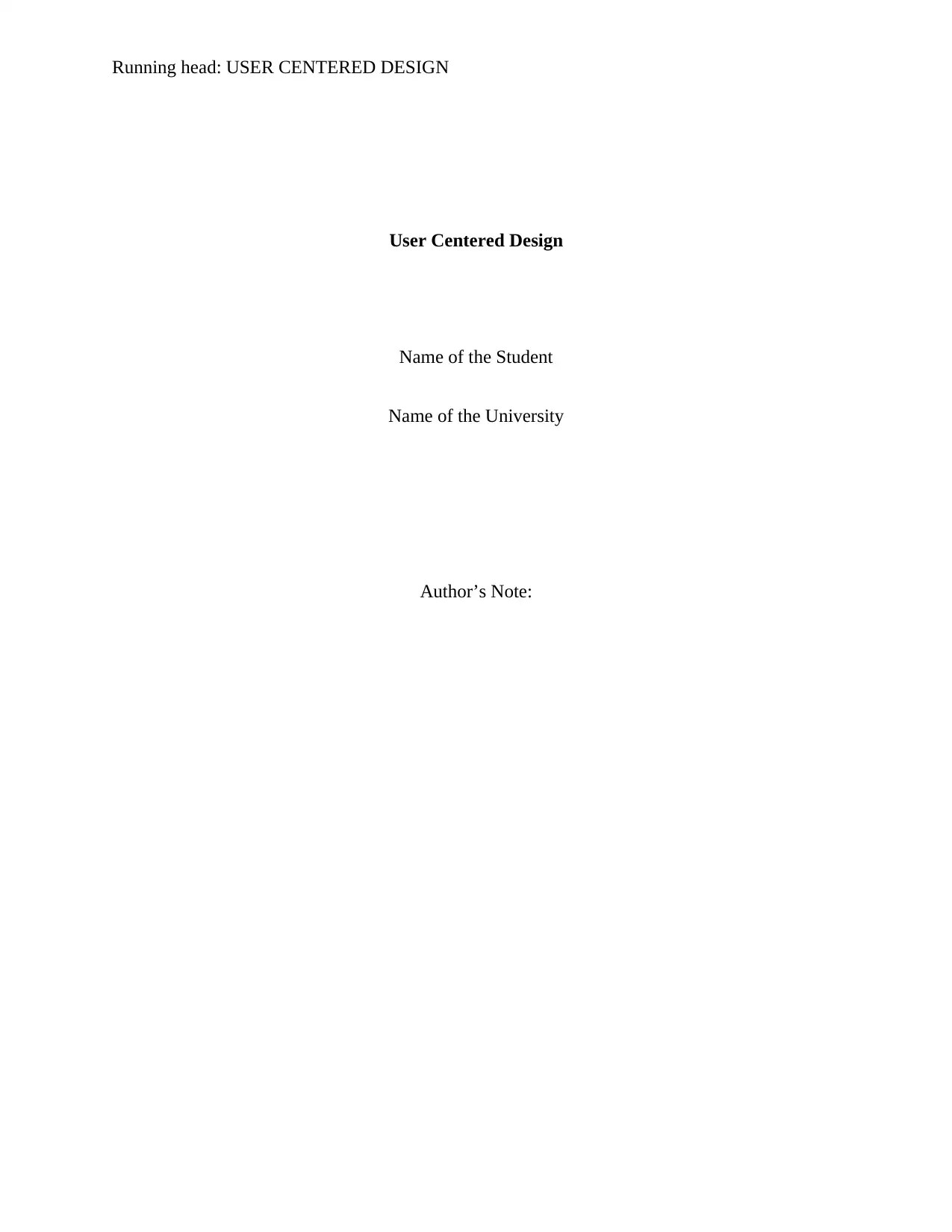
Running head: USER CENTERED DESIGN
User Centered Design
Name of the Student
Name of the University
Author’s Note:
User Centered Design
Name of the Student
Name of the University
Author’s Note:
Paraphrase This Document
Need a fresh take? Get an instant paraphrase of this document with our AI Paraphraser
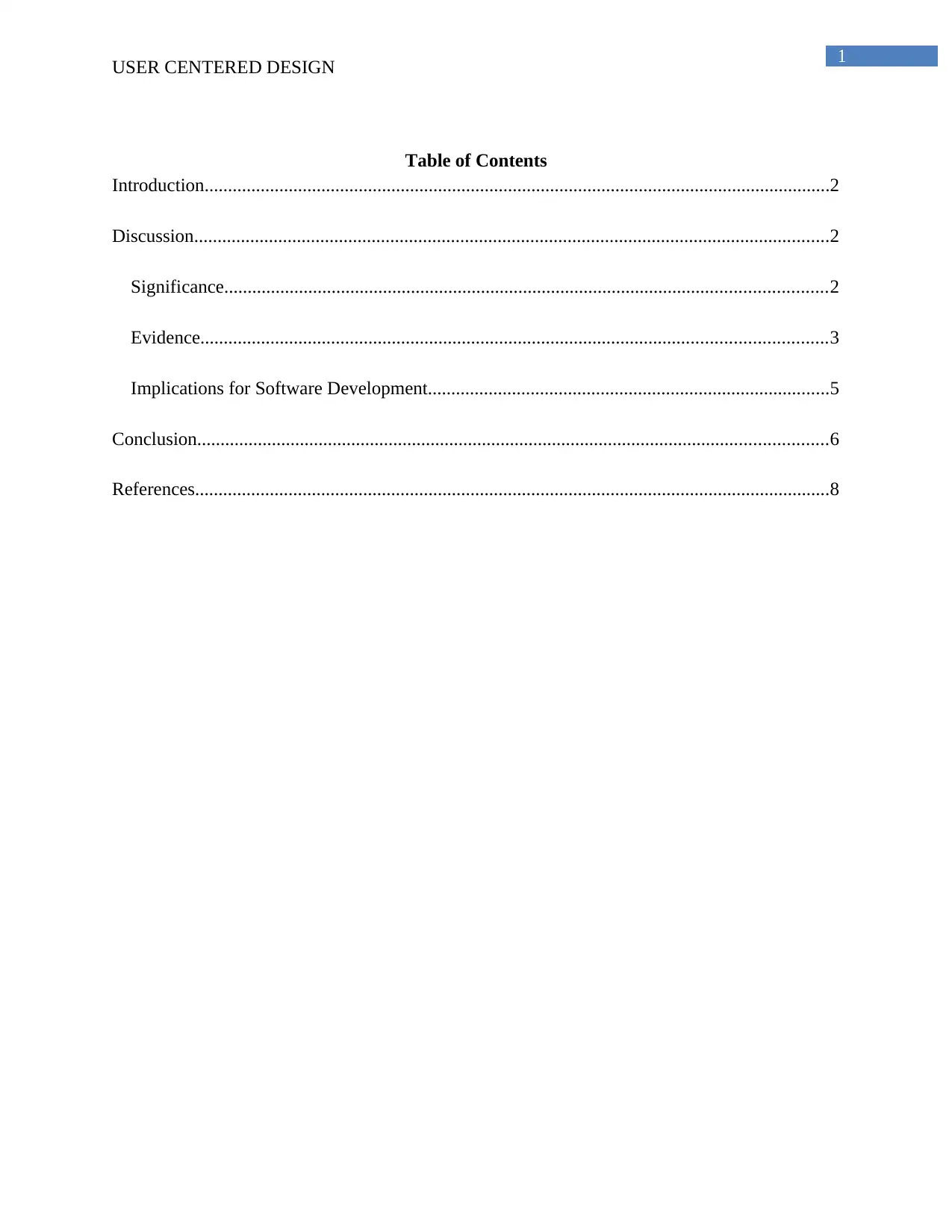
1
USER CENTERED DESIGN
Table of Contents
Introduction......................................................................................................................................2
Discussion........................................................................................................................................2
Significance.................................................................................................................................2
Evidence......................................................................................................................................3
Implications for Software Development......................................................................................5
Conclusion.......................................................................................................................................6
References........................................................................................................................................8
USER CENTERED DESIGN
Table of Contents
Introduction......................................................................................................................................2
Discussion........................................................................................................................................2
Significance.................................................................................................................................2
Evidence......................................................................................................................................3
Implications for Software Development......................................................................................5
Conclusion.......................................................................................................................................6
References........................................................................................................................................8
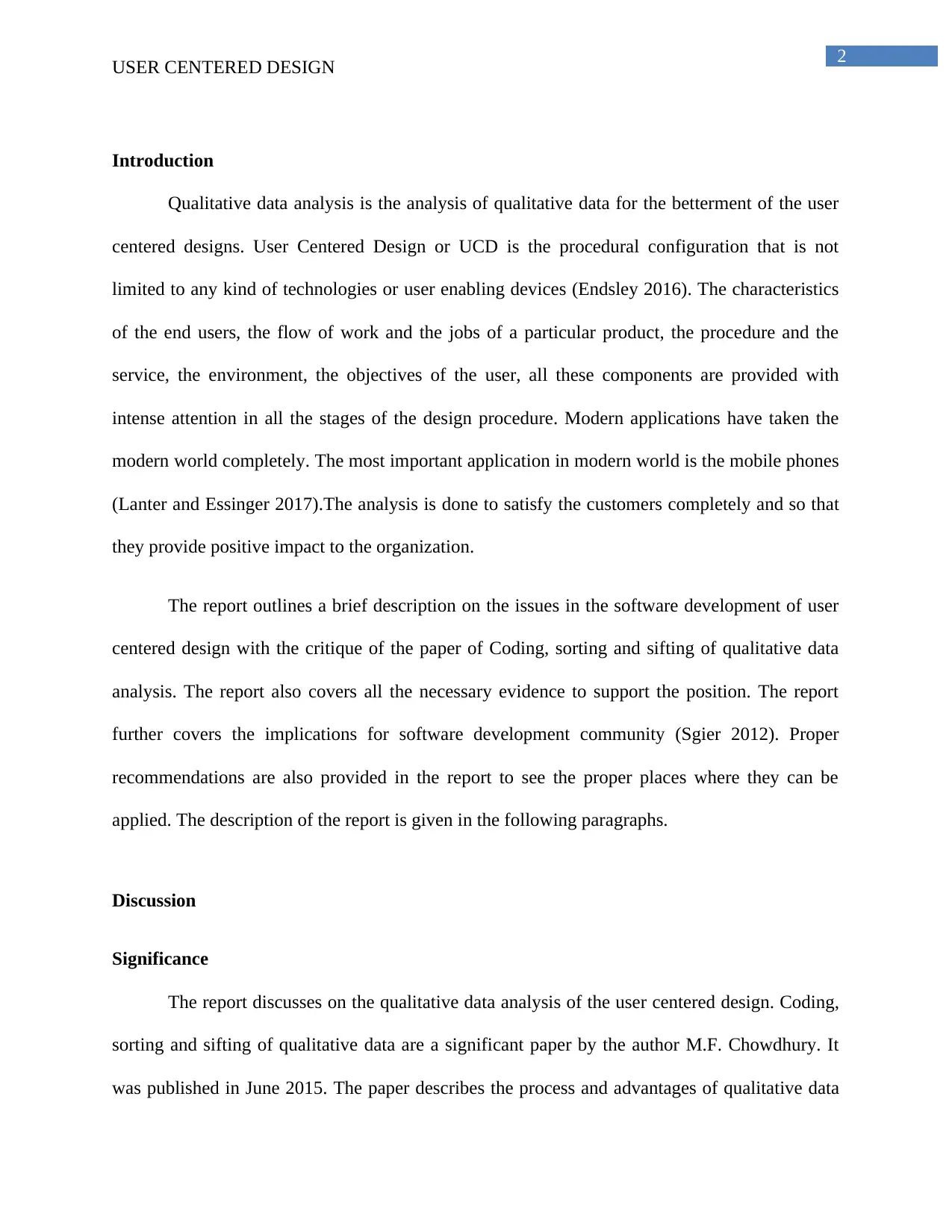
2
USER CENTERED DESIGN
Introduction
Qualitative data analysis is the analysis of qualitative data for the betterment of the user
centered designs. User Centered Design or UCD is the procedural configuration that is not
limited to any kind of technologies or user enabling devices (Endsley 2016). The characteristics
of the end users, the flow of work and the jobs of a particular product, the procedure and the
service, the environment, the objectives of the user, all these components are provided with
intense attention in all the stages of the design procedure. Modern applications have taken the
modern world completely. The most important application in modern world is the mobile phones
(Lanter and Essinger 2017).The analysis is done to satisfy the customers completely and so that
they provide positive impact to the organization.
The report outlines a brief description on the issues in the software development of user
centered design with the critique of the paper of Coding, sorting and sifting of qualitative data
analysis. The report also covers all the necessary evidence to support the position. The report
further covers the implications for software development community (Sgier 2012). Proper
recommendations are also provided in the report to see the proper places where they can be
applied. The description of the report is given in the following paragraphs.
Discussion
Significance
The report discusses on the qualitative data analysis of the user centered design. Coding,
sorting and sifting of qualitative data are a significant paper by the author M.F. Chowdhury. It
was published in June 2015. The paper describes the process and advantages of qualitative data
USER CENTERED DESIGN
Introduction
Qualitative data analysis is the analysis of qualitative data for the betterment of the user
centered designs. User Centered Design or UCD is the procedural configuration that is not
limited to any kind of technologies or user enabling devices (Endsley 2016). The characteristics
of the end users, the flow of work and the jobs of a particular product, the procedure and the
service, the environment, the objectives of the user, all these components are provided with
intense attention in all the stages of the design procedure. Modern applications have taken the
modern world completely. The most important application in modern world is the mobile phones
(Lanter and Essinger 2017).The analysis is done to satisfy the customers completely and so that
they provide positive impact to the organization.
The report outlines a brief description on the issues in the software development of user
centered design with the critique of the paper of Coding, sorting and sifting of qualitative data
analysis. The report also covers all the necessary evidence to support the position. The report
further covers the implications for software development community (Sgier 2012). Proper
recommendations are also provided in the report to see the proper places where they can be
applied. The description of the report is given in the following paragraphs.
Discussion
Significance
The report discusses on the qualitative data analysis of the user centered design. Coding,
sorting and sifting of qualitative data are a significant paper by the author M.F. Chowdhury. It
was published in June 2015. The paper describes the process and advantages of qualitative data
⊘ This is a preview!⊘
Do you want full access?
Subscribe today to unlock all pages.

Trusted by 1+ million students worldwide
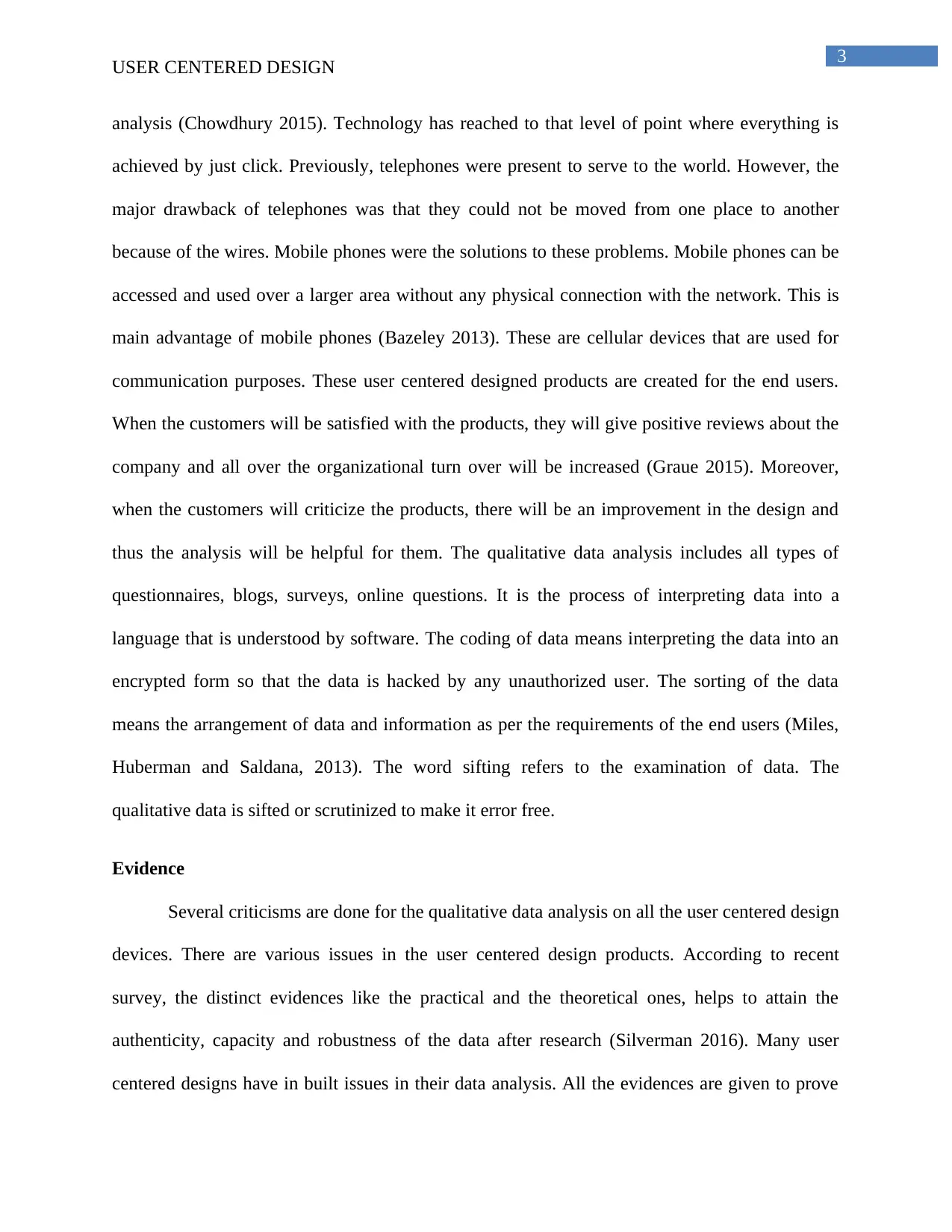
3
USER CENTERED DESIGN
analysis (Chowdhury 2015). Technology has reached to that level of point where everything is
achieved by just click. Previously, telephones were present to serve to the world. However, the
major drawback of telephones was that they could not be moved from one place to another
because of the wires. Mobile phones were the solutions to these problems. Mobile phones can be
accessed and used over a larger area without any physical connection with the network. This is
main advantage of mobile phones (Bazeley 2013). These are cellular devices that are used for
communication purposes. These user centered designed products are created for the end users.
When the customers will be satisfied with the products, they will give positive reviews about the
company and all over the organizational turn over will be increased (Graue 2015). Moreover,
when the customers will criticize the products, there will be an improvement in the design and
thus the analysis will be helpful for them. The qualitative data analysis includes all types of
questionnaires, blogs, surveys, online questions. It is the process of interpreting data into a
language that is understood by software. The coding of data means interpreting the data into an
encrypted form so that the data is hacked by any unauthorized user. The sorting of the data
means the arrangement of data and information as per the requirements of the end users (Miles,
Huberman and Saldana, 2013). The word sifting refers to the examination of data. The
qualitative data is sifted or scrutinized to make it error free.
Evidence
Several criticisms are done for the qualitative data analysis on all the user centered design
devices. There are various issues in the user centered design products. According to recent
survey, the distinct evidences like the practical and the theoretical ones, helps to attain the
authenticity, capacity and robustness of the data after research (Silverman 2016). Many user
centered designs have in built issues in their data analysis. All the evidences are given to prove
USER CENTERED DESIGN
analysis (Chowdhury 2015). Technology has reached to that level of point where everything is
achieved by just click. Previously, telephones were present to serve to the world. However, the
major drawback of telephones was that they could not be moved from one place to another
because of the wires. Mobile phones were the solutions to these problems. Mobile phones can be
accessed and used over a larger area without any physical connection with the network. This is
main advantage of mobile phones (Bazeley 2013). These are cellular devices that are used for
communication purposes. These user centered designed products are created for the end users.
When the customers will be satisfied with the products, they will give positive reviews about the
company and all over the organizational turn over will be increased (Graue 2015). Moreover,
when the customers will criticize the products, there will be an improvement in the design and
thus the analysis will be helpful for them. The qualitative data analysis includes all types of
questionnaires, blogs, surveys, online questions. It is the process of interpreting data into a
language that is understood by software. The coding of data means interpreting the data into an
encrypted form so that the data is hacked by any unauthorized user. The sorting of the data
means the arrangement of data and information as per the requirements of the end users (Miles,
Huberman and Saldana, 2013). The word sifting refers to the examination of data. The
qualitative data is sifted or scrutinized to make it error free.
Evidence
Several criticisms are done for the qualitative data analysis on all the user centered design
devices. There are various issues in the user centered design products. According to recent
survey, the distinct evidences like the practical and the theoretical ones, helps to attain the
authenticity, capacity and robustness of the data after research (Silverman 2016). Many user
centered designs have in built issues in their data analysis. All the evidences are given to prove
Paraphrase This Document
Need a fresh take? Get an instant paraphrase of this document with our AI Paraphraser
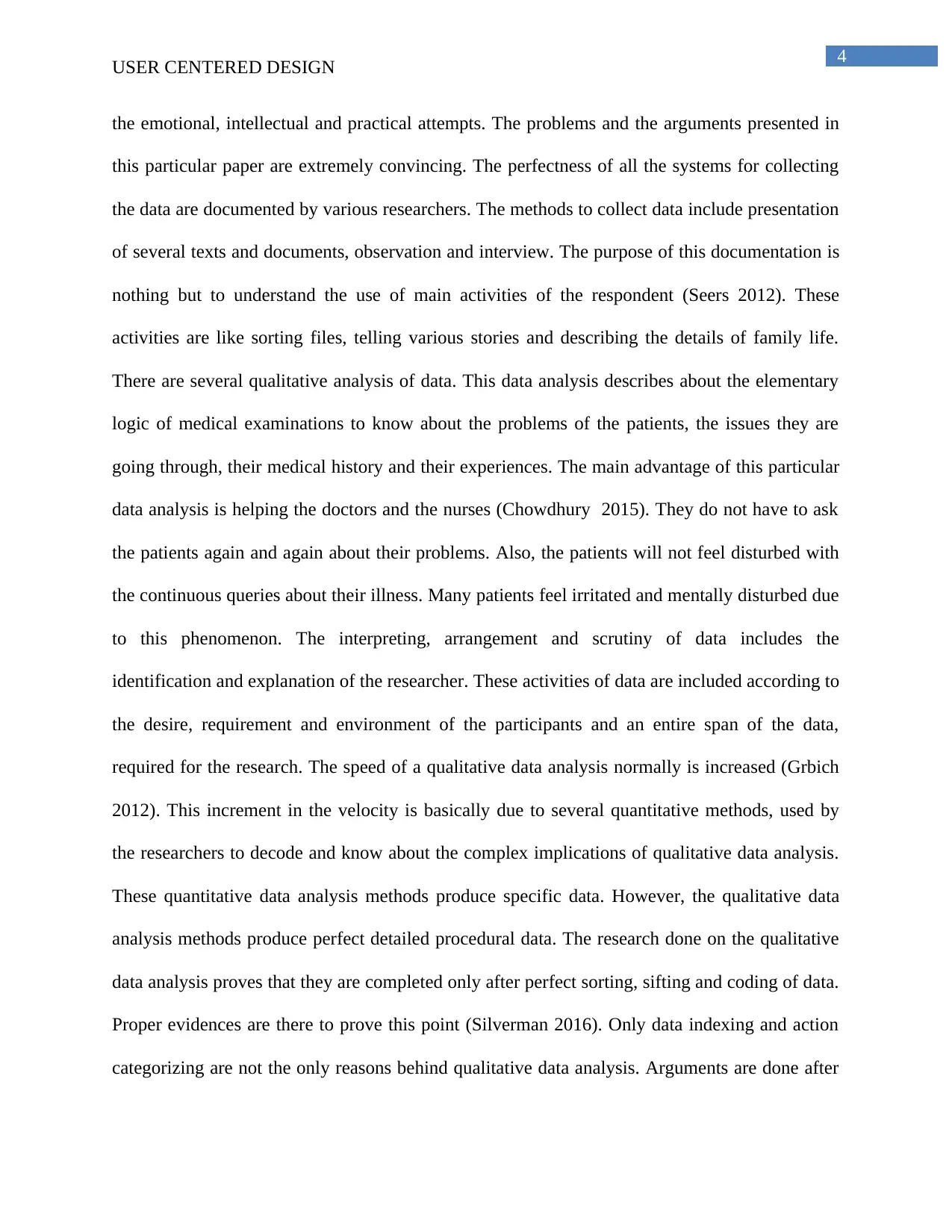
4
USER CENTERED DESIGN
the emotional, intellectual and practical attempts. The problems and the arguments presented in
this particular paper are extremely convincing. The perfectness of all the systems for collecting
the data are documented by various researchers. The methods to collect data include presentation
of several texts and documents, observation and interview. The purpose of this documentation is
nothing but to understand the use of main activities of the respondent (Seers 2012). These
activities are like sorting files, telling various stories and describing the details of family life.
There are several qualitative analysis of data. This data analysis describes about the elementary
logic of medical examinations to know about the problems of the patients, the issues they are
going through, their medical history and their experiences. The main advantage of this particular
data analysis is helping the doctors and the nurses (Chowdhury 2015). They do not have to ask
the patients again and again about their problems. Also, the patients will not feel disturbed with
the continuous queries about their illness. Many patients feel irritated and mentally disturbed due
to this phenomenon. The interpreting, arrangement and scrutiny of data includes the
identification and explanation of the researcher. These activities of data are included according to
the desire, requirement and environment of the participants and an entire span of the data,
required for the research. The speed of a qualitative data analysis normally is increased (Grbich
2012). This increment in the velocity is basically due to several quantitative methods, used by
the researchers to decode and know about the complex implications of qualitative data analysis.
These quantitative data analysis methods produce specific data. However, the qualitative data
analysis methods produce perfect detailed procedural data. The research done on the qualitative
data analysis proves that they are completed only after perfect sorting, sifting and coding of data.
Proper evidences are there to prove this point (Silverman 2016). Only data indexing and action
categorizing are not the only reasons behind qualitative data analysis. Arguments are done after
USER CENTERED DESIGN
the emotional, intellectual and practical attempts. The problems and the arguments presented in
this particular paper are extremely convincing. The perfectness of all the systems for collecting
the data are documented by various researchers. The methods to collect data include presentation
of several texts and documents, observation and interview. The purpose of this documentation is
nothing but to understand the use of main activities of the respondent (Seers 2012). These
activities are like sorting files, telling various stories and describing the details of family life.
There are several qualitative analysis of data. This data analysis describes about the elementary
logic of medical examinations to know about the problems of the patients, the issues they are
going through, their medical history and their experiences. The main advantage of this particular
data analysis is helping the doctors and the nurses (Chowdhury 2015). They do not have to ask
the patients again and again about their problems. Also, the patients will not feel disturbed with
the continuous queries about their illness. Many patients feel irritated and mentally disturbed due
to this phenomenon. The interpreting, arrangement and scrutiny of data includes the
identification and explanation of the researcher. These activities of data are included according to
the desire, requirement and environment of the participants and an entire span of the data,
required for the research. The speed of a qualitative data analysis normally is increased (Grbich
2012). This increment in the velocity is basically due to several quantitative methods, used by
the researchers to decode and know about the complex implications of qualitative data analysis.
These quantitative data analysis methods produce specific data. However, the qualitative data
analysis methods produce perfect detailed procedural data. The research done on the qualitative
data analysis proves that they are completed only after perfect sorting, sifting and coding of data.
Proper evidences are there to prove this point (Silverman 2016). Only data indexing and action
categorizing are not the only reasons behind qualitative data analysis. Arguments are done after

5
USER CENTERED DESIGN
comparison and contrasting the qualitative and quantitative data analyses within several
researchers. The qualitative data analysis has several features like flexibility and scalability. This
makes the analysis extremely simple and easier.
Implications for Software Development
The procedure of programming, testing and fixing of bugs that is utilized to generate an
application is known as software development. This software development involves with any
kind of Internet enabled system to create a particular software. There are several implications of
this paper in the software development community. The changes and the alterations in software
development recognize several important implications (Salanova, Llorens and Cifre 2013). The
first implication of software development community is the selection of software development
methodologies. The first implication in this paper is the handling and managing of bulk data with
efficiency and ease through the applications of the computer. The coding, sorting and scrutiny of
qualitative data are completed by the famous and the modern integrated technology known as the
ICT or information and communication technology. ICT is an extension of information
technology that focuses on the integration of communication and telecommunications (Bazeley
2013). The second implication says that since testing of software is the most important action in
development of software, then what will be the best approaches in combining testing into
development. The third implication says that the software testers are the most important players
in the software development process. It answers various questions like what will be the change in
the data once the software is implemented. This paper helps to understand the necessity and
simplicity of the integration of information and communications technology with the qualitative
data analysis in recent days (Baguley et al. 2014). The first recommendation is for the companies
of user centered design products. They should focus on the quality of their equipments used for
USER CENTERED DESIGN
comparison and contrasting the qualitative and quantitative data analyses within several
researchers. The qualitative data analysis has several features like flexibility and scalability. This
makes the analysis extremely simple and easier.
Implications for Software Development
The procedure of programming, testing and fixing of bugs that is utilized to generate an
application is known as software development. This software development involves with any
kind of Internet enabled system to create a particular software. There are several implications of
this paper in the software development community. The changes and the alterations in software
development recognize several important implications (Salanova, Llorens and Cifre 2013). The
first implication of software development community is the selection of software development
methodologies. The first implication in this paper is the handling and managing of bulk data with
efficiency and ease through the applications of the computer. The coding, sorting and scrutiny of
qualitative data are completed by the famous and the modern integrated technology known as the
ICT or information and communication technology. ICT is an extension of information
technology that focuses on the integration of communication and telecommunications (Bazeley
2013). The second implication says that since testing of software is the most important action in
development of software, then what will be the best approaches in combining testing into
development. The third implication says that the software testers are the most important players
in the software development process. It answers various questions like what will be the change in
the data once the software is implemented. This paper helps to understand the necessity and
simplicity of the integration of information and communications technology with the qualitative
data analysis in recent days (Baguley et al. 2014). The first recommendation is for the companies
of user centered design products. They should focus on the quality of their equipments used for
⊘ This is a preview!⊘
Do you want full access?
Subscribe today to unlock all pages.

Trusted by 1+ million students worldwide
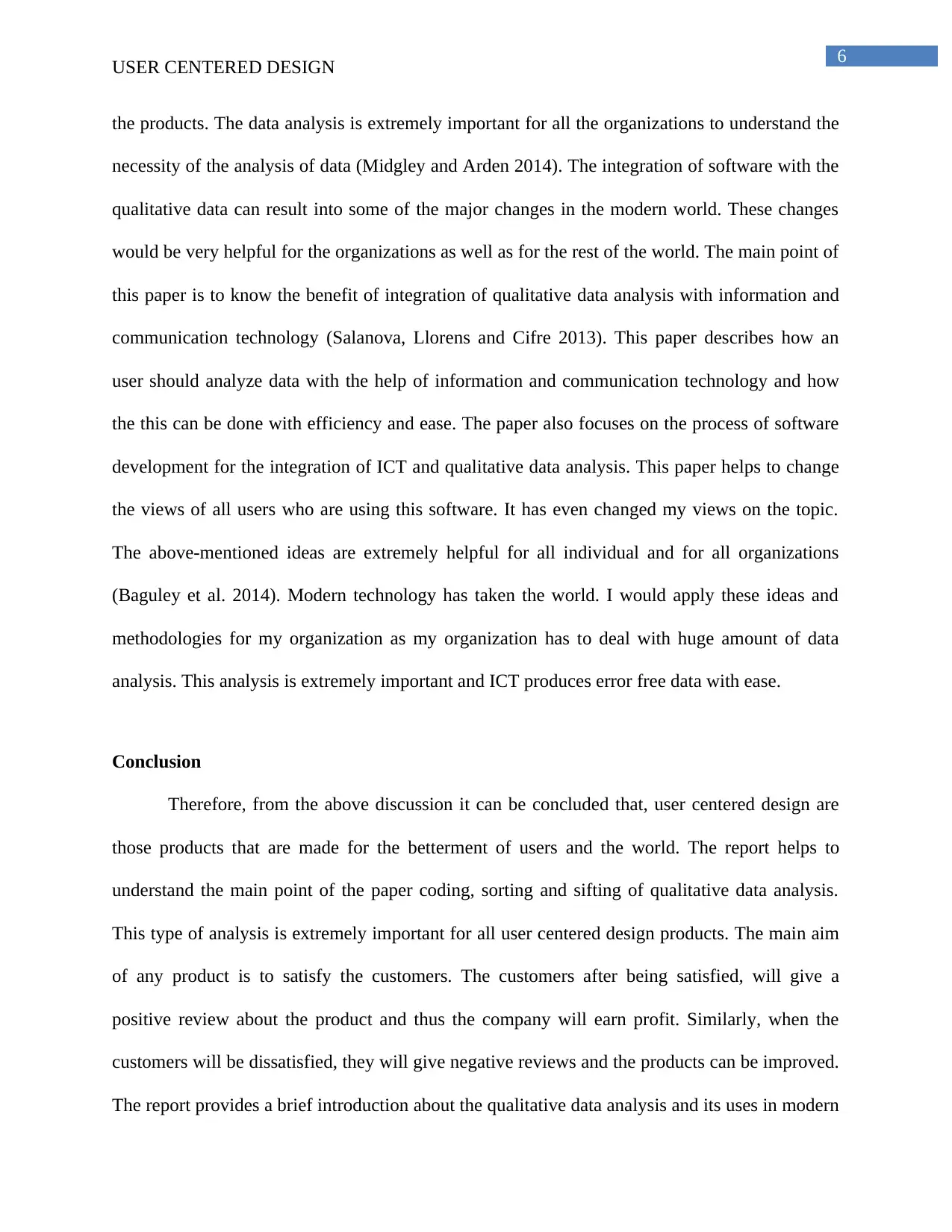
6
USER CENTERED DESIGN
the products. The data analysis is extremely important for all the organizations to understand the
necessity of the analysis of data (Midgley and Arden 2014). The integration of software with the
qualitative data can result into some of the major changes in the modern world. These changes
would be very helpful for the organizations as well as for the rest of the world. The main point of
this paper is to know the benefit of integration of qualitative data analysis with information and
communication technology (Salanova, Llorens and Cifre 2013). This paper describes how an
user should analyze data with the help of information and communication technology and how
the this can be done with efficiency and ease. The paper also focuses on the process of software
development for the integration of ICT and qualitative data analysis. This paper helps to change
the views of all users who are using this software. It has even changed my views on the topic.
The above-mentioned ideas are extremely helpful for all individual and for all organizations
(Baguley et al. 2014). Modern technology has taken the world. I would apply these ideas and
methodologies for my organization as my organization has to deal with huge amount of data
analysis. This analysis is extremely important and ICT produces error free data with ease.
Conclusion
Therefore, from the above discussion it can be concluded that, user centered design are
those products that are made for the betterment of users and the world. The report helps to
understand the main point of the paper coding, sorting and sifting of qualitative data analysis.
This type of analysis is extremely important for all user centered design products. The main aim
of any product is to satisfy the customers. The customers after being satisfied, will give a
positive review about the product and thus the company will earn profit. Similarly, when the
customers will be dissatisfied, they will give negative reviews and the products can be improved.
The report provides a brief introduction about the qualitative data analysis and its uses in modern
USER CENTERED DESIGN
the products. The data analysis is extremely important for all the organizations to understand the
necessity of the analysis of data (Midgley and Arden 2014). The integration of software with the
qualitative data can result into some of the major changes in the modern world. These changes
would be very helpful for the organizations as well as for the rest of the world. The main point of
this paper is to know the benefit of integration of qualitative data analysis with information and
communication technology (Salanova, Llorens and Cifre 2013). This paper describes how an
user should analyze data with the help of information and communication technology and how
the this can be done with efficiency and ease. The paper also focuses on the process of software
development for the integration of ICT and qualitative data analysis. This paper helps to change
the views of all users who are using this software. It has even changed my views on the topic.
The above-mentioned ideas are extremely helpful for all individual and for all organizations
(Baguley et al. 2014). Modern technology has taken the world. I would apply these ideas and
methodologies for my organization as my organization has to deal with huge amount of data
analysis. This analysis is extremely important and ICT produces error free data with ease.
Conclusion
Therefore, from the above discussion it can be concluded that, user centered design are
those products that are made for the betterment of users and the world. The report helps to
understand the main point of the paper coding, sorting and sifting of qualitative data analysis.
This type of analysis is extremely important for all user centered design products. The main aim
of any product is to satisfy the customers. The customers after being satisfied, will give a
positive review about the product and thus the company will earn profit. Similarly, when the
customers will be dissatisfied, they will give negative reviews and the products can be improved.
The report provides a brief introduction about the qualitative data analysis and its uses in modern
Paraphrase This Document
Need a fresh take? Get an instant paraphrase of this document with our AI Paraphraser

7
USER CENTERED DESIGN
life. The report also gives various arguments and evidences for the problem and to prove the
point that how convincing the point is. The report also covers the major implications of software
development and recommended ideas for applying this particular theory in the work practice of
an organization.
USER CENTERED DESIGN
life. The report also gives various arguments and evidences for the problem and to prove the
point that how convincing the point is. The report also covers the major implications of software
development and recommended ideas for applying this particular theory in the work practice of
an organization.
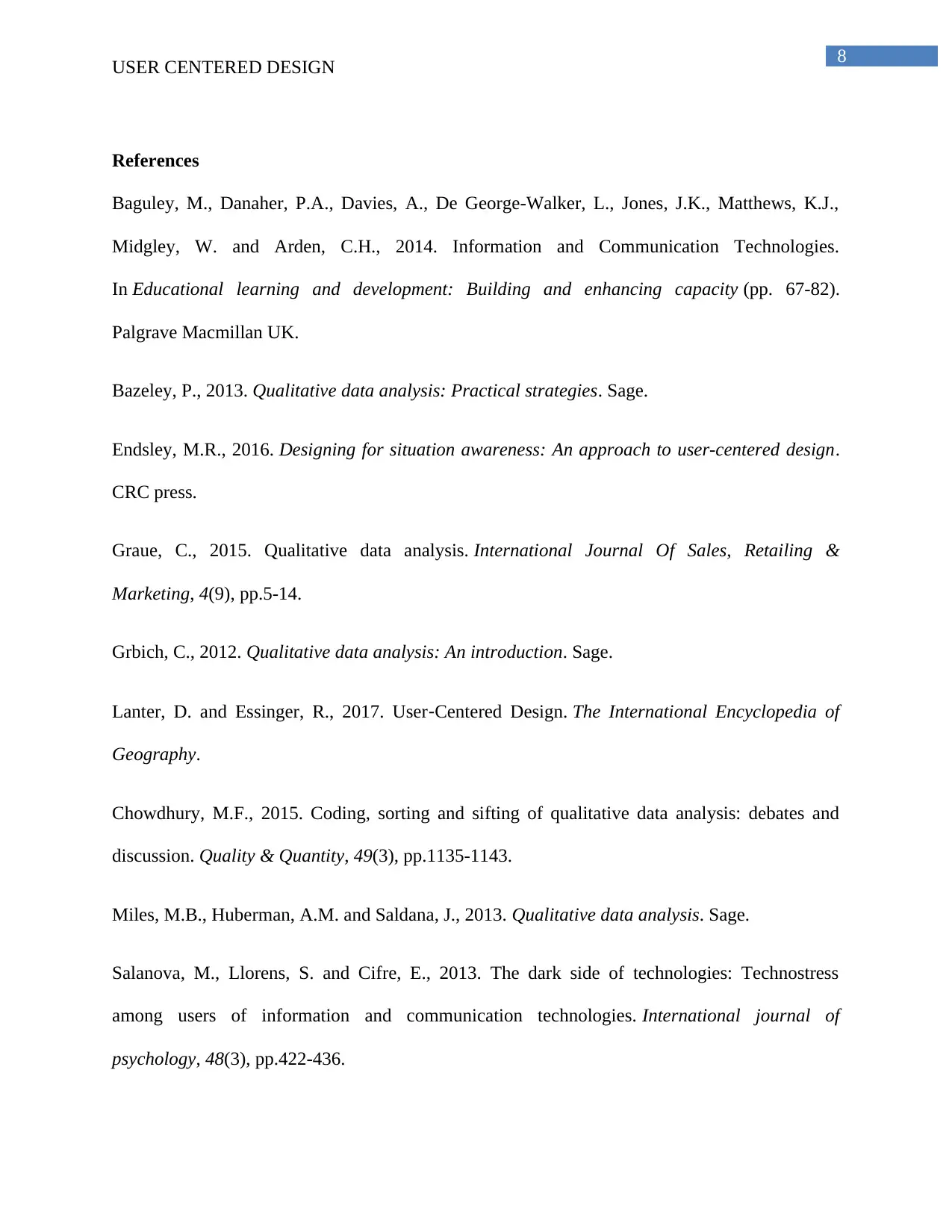
8
USER CENTERED DESIGN
References
Baguley, M., Danaher, P.A., Davies, A., De George-Walker, L., Jones, J.K., Matthews, K.J.,
Midgley, W. and Arden, C.H., 2014. Information and Communication Technologies.
In Educational learning and development: Building and enhancing capacity (pp. 67-82).
Palgrave Macmillan UK.
Bazeley, P., 2013. Qualitative data analysis: Practical strategies. Sage.
Endsley, M.R., 2016. Designing for situation awareness: An approach to user-centered design.
CRC press.
Graue, C., 2015. Qualitative data analysis. International Journal Of Sales, Retailing &
Marketing, 4(9), pp.5-14.
Grbich, C., 2012. Qualitative data analysis: An introduction. Sage.
Lanter, D. and Essinger, R., 2017. User‐Centered Design. The International Encyclopedia of
Geography.
Chowdhury, M.F., 2015. Coding, sorting and sifting of qualitative data analysis: debates and
discussion. Quality & Quantity, 49(3), pp.1135-1143.
Miles, M.B., Huberman, A.M. and Saldana, J., 2013. Qualitative data analysis. Sage.
Salanova, M., Llorens, S. and Cifre, E., 2013. The dark side of technologies: Technostress
among users of information and communication technologies. International journal of
psychology, 48(3), pp.422-436.
USER CENTERED DESIGN
References
Baguley, M., Danaher, P.A., Davies, A., De George-Walker, L., Jones, J.K., Matthews, K.J.,
Midgley, W. and Arden, C.H., 2014. Information and Communication Technologies.
In Educational learning and development: Building and enhancing capacity (pp. 67-82).
Palgrave Macmillan UK.
Bazeley, P., 2013. Qualitative data analysis: Practical strategies. Sage.
Endsley, M.R., 2016. Designing for situation awareness: An approach to user-centered design.
CRC press.
Graue, C., 2015. Qualitative data analysis. International Journal Of Sales, Retailing &
Marketing, 4(9), pp.5-14.
Grbich, C., 2012. Qualitative data analysis: An introduction. Sage.
Lanter, D. and Essinger, R., 2017. User‐Centered Design. The International Encyclopedia of
Geography.
Chowdhury, M.F., 2015. Coding, sorting and sifting of qualitative data analysis: debates and
discussion. Quality & Quantity, 49(3), pp.1135-1143.
Miles, M.B., Huberman, A.M. and Saldana, J., 2013. Qualitative data analysis. Sage.
Salanova, M., Llorens, S. and Cifre, E., 2013. The dark side of technologies: Technostress
among users of information and communication technologies. International journal of
psychology, 48(3), pp.422-436.
⊘ This is a preview!⊘
Do you want full access?
Subscribe today to unlock all pages.

Trusted by 1+ million students worldwide

9
USER CENTERED DESIGN
Seers, K., 2012. Qualitative data analysis. Evidence-based nursing, 15(1), pp.2-2.
Sgier, L., 2012. Qualitative data analysis.
Silverman, D. ed., 2016. Qualitative research. Sage.
USER CENTERED DESIGN
Seers, K., 2012. Qualitative data analysis. Evidence-based nursing, 15(1), pp.2-2.
Sgier, L., 2012. Qualitative data analysis.
Silverman, D. ed., 2016. Qualitative research. Sage.
1 out of 10
Related Documents
Your All-in-One AI-Powered Toolkit for Academic Success.
+13062052269
info@desklib.com
Available 24*7 on WhatsApp / Email
![[object Object]](/_next/static/media/star-bottom.7253800d.svg)
Unlock your academic potential
Copyright © 2020–2025 A2Z Services. All Rights Reserved. Developed and managed by ZUCOL.





